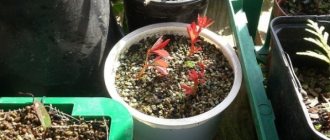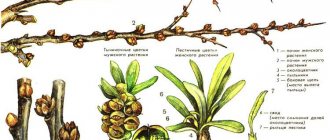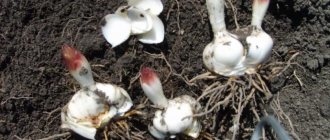Reproduction of lilies by scales
This is a universal method. Using it you can get a large amount of planting material. The particular value of the method is that it can be used to propagate both varietal and species lilies (those that do not form bulbs)
Numerous juicy scales that are easily separated from the “mother” form a bulb. Each individual scale can produce new small bulbs. Lilies are propagated using this method throughout the year. However, in spring the formation of young bulbs occurs much faster.
If the bulb was purchased in late autumn or early spring and is well preserved, then propagation can begin with the arrival of spring. One bulb, without compromising flowering, allows you to “take away” up to 1/3 of all outer scales.
Separating scales from a growing lily is also possible. To do this, they scrape away the soil from the shoot and, without digging, separate the scales. The remains of the onion with the shoot are sprinkled with soil and watered.
Don't be greedy. Do not separate more than 1/3 of the scales.
The separated scales should be washed under running water and disinfected for 15-20 minutes in a bright solution of potassium permanganate. Next, dry it slightly.
If you treat the scales in a solution of succinic acid (100 mg/l for 6 hours), the number of bulbs will increase by 1.5 times, and their size by 2.
The best timing for cuttings is:
- Asian hybrids and royal ones (Regale) - spring;
- Tubular - flowering phase.
If you adhere to the optimal timing, the yield of young bulbs is much higher.
Place the prepared scales in thick plastic bags with slightly damp:
- perlite;
- sawdust;
- sphagnum moss;
- sand;
- matured peat;
- charcoal.
If you want to propagate several varieties, each should be given a separate bag. We sign each package. The bag should not be compressed tightly. There should be some air in it. We put the bags in some dark place until small bulbs form (you can organize a box in the closet).
Storage periods and temperature conditions are as follows:
| Deadlines | Temperature |
| First 6 weeks | 22 - 25 ᵒC |
| Next 4 weeks | 16 — 18 ᵒC |
| Until landing | 5ᵒC |
After time, the scales with newly formed bulbs are planted in boxes or pots with soil and even a school of open ground. Planting depth is 1.5 times the height of the bulb.
New plantations should:
- water thoroughly;
- build a shady shelter;
- mulch with peat chips or other material.
It should be taken into account that lilies prefer places protected from the wind with light, alkaline soils, without stagnant water.
Young roots are very weak. They are found in the surface layer of soil. Given this feature, it is better not to loosen the soil, but mulching will help maintain optimal moisture. Regular treatments against pests, mulching and watering will help quickly take root and grow. The soil should not dry out, but excessive moisture is also harmful.
In the second year after planting, many plants are already trying to bloom, but usually the first flowering is very weak. The formed buds should be torn off. All forces must go towards the growth of the bulb.
As a rule, by the third year the plants reach full strength, bloom profusely, and by autumn a full-fledged, large bulb is formed underground. Such bulbs can even be left for winter-spring forcing.
Step-by-step instructions: propagation of eucharis by seeds. Pros and cons of the method
Eucharis is an unpretentious indoor plant that resembles a daffodil in appearance. The flowering period begins in winter, which makes this magnificent flower stand out among its peers.
On frosty days, when the sun rarely peeks through the windows, blooming eucharis looks gorgeous on the windowsill, spreading a subtle, unique aroma. Without a doubt, this wonderful flower will take its rightful place among the decorations of any room, but we’ll find out how to propagate it from seeds further.
A little about the plant
Eucharis is a representative of the genus of bulbous plants, belongs to the Amaryllidaceae family. The family has about a thousand species, most of it are ornamental plants. These herbaceous perennial inhabitants of the tropics and subtropics differ in the size and shape of the bulbs, the arrangement of leaves and flowers.
REFERENCE . Snowdrops and onions also belong to the Amaryllis family.
Eucharis is also called the Amazon lily. This amazing flower has earned popularity among gardeners due to its unpretentiousness and ability to maintain an attractive appearance throughout the year with proper care.
What do Eucharis seeds look like?
The seed is a tiny bulb enclosed in a protective shell. When it finds favorable conditions for development, it begins to increase in size and germinate.
The dark brown seeds are flat and flattened, with a small bump in the middle. A tubercle is a plant embryo with a small supply of nutrients that ensures the viability of the seed during the dormant period.
Where can I get them?
- Seeds can be purchased at a specialized store, where you will be advised on the rules of planting and further care of the plants.
- You can choose the flower you like in the online store based on photographs and receive the seeds by mail. They tolerate transportation well.
- The most reliable way to get exactly the plant you like is to collect seeds from your own existing flower.
How to get it at home?
If a decision is made to germinate eucharis seeds, then to successfully implement this propagation method it is necessary to go through several stages .
Pollination of a flower
- You should wait for flowering and pollinate the pistil of the plant.
- When the pistil is covered with a thin layer of sticky liquid, you need to run a soft brush over the stamens (collect pollen) and then wipe the pistil.
Once on the sticky surface, the stamens begin to germinate, forming seed boxes. This process can take a long time, up to thirty days. - After wilting, the bud falls off, leaving behind a seed capsule, which, having reached its maximum size, opens, exposing dark-colored seeds.
IMPORTANT! The maximum number of seedlings will occur when planting fresh ripened seeds.
Seed germination
Amazon lily seeds can be stored for up to 1.5 years. If stored without soil for a longer period of time, the miniature bulb dries out and it is impossible to obtain a healthy plant from it. Fresh seeds are considered the most viable ; germination rate is 90%.
- The germination container should be wide, with holes for draining water.
- The soil consists of black soil with the addition of sand. The seeds are distributed at a short distance from each other and sprinkled with soil.
- It is better to moisten the planted plants using a spray bottle. It is not necessary to cover with a lid; the seeds germinate well in the open air, without a greenhouse.
- Avoid exposure to direct sunlight, drying out and waterlogging of the soil.
- To germinate seeds, it is enough to take a container 5 cm deep.
What to do when sprouts appear?
Further development will require replanting two or three months after the seeds have sprouted . Without dividing the bulbs (by the total mass of the soil), move the strengthened seedlings into a container with a diameter of 12 cm and a depth of 9 cm, where they will develop for 1.5 years. After this, you can separate and plant the bulbs.
ATTENTION! From the moment of planting the eucharis seeds to the time of flowering, at least 3 to 4 years will pass.
Is it worth growing seedlings: the pros and cons of the method
Propagating Amazon lilies by seeds has both its advantages and disadvantages.
Advantages
- Seeds can be bought in a store or market for a small price; They are convenient for transportation, as they are protected from damage by the shell.
- The bulb, enclosed in a shell, can be stored separately from the parent plant due to the nutrients contained in the seed for a long time, maintaining viability.
- Only when using the seed propagation method is it possible to simultaneously obtain a large number of healthy plants.
- When propagating from seeds, it becomes possible to cross different types of plants to obtain new shades or aromas.
Flaws
- When using store-bought seeds, you never know what flower you actually bought until it blooms.
- To get seeds, you need to transfer pollen to the plant's pistil. If this is not done, pollination will not occur and seeds will not form.
- When choosing the seed method, you should keep in mind that the process takes a long time, so you will have to be patient.
- Only fresh seeds have high germination rate. The longer the seeds are stored, the less chance of germination and many seeds die.
- In order for the plant to bloom for a long time, faded buds should be trimmed. If you plan to collect seeds, the parent flower spends a lot of vitality and energy on their production; due to this it becomes weaker.
Other ways to propagate a flower
- Children - the simplest and most convenient way, which does not require special knowledge and subtleties. When dividing a bush, you should plant four or five daughter bulbs in each pot.
- Dividing the bulb is the most difficult method, which only experienced gardeners can do.
Cut the top of the onion into four pieces in the shape of a cross, slightly short of the base. Insert thin sticks into the cuts to secure each part individually and continue caring for the bulb. After some time, four separate onions should sprout.
Having studied the methods of breeding Amazon lilies, you can choose the most suitable one for yourself.
Conclusion
The method of propagation by seeds is labor-intensive and time-consuming, does not always bring positive results and requires certain skills from the grower.
The complex process of seed propagation is used for mass planting or when species are crossed (the pistil of one plant species is pollinated by the stamens of another related specimen) to produce new shades.
Source: https://na-zemle.info/komnatnye-rasteniya/dekorativno-cvetushhie/euxaris/razmnozhenie/semenami.html
Propagation of lilies by dividing nests of bulbs
When thinking about how to propagate lilies, flower growers most often give preference to this method. During its life, the lily bulb forms several renewal buds. In terms of time, to form a large nest you will need:
- Asian - 3-4 years;
- tubular - 5-6 years.
Multiple flower stalks from one bulb can be a signal for division of lily nests.
The lily has bloomed. What to do and when to start breeding? Immediately after flowering, tear off the seed pods if you do not plan to propagate by seeds. Give the Vetons the opportunity to independently transfer nutrients to the tuber.
You cannot cut off the lily flower stalk immediately after flowering.
Reproduction by dividing nests is possible only after 1 - 1.5 months. This time is needed for:
- restoration of nutrients;
- preparation for flowering next year;
- carry out all biochemical processes for a successful wintering.
Division time: end of August, beginning of September. The nest is carefully dug up, carefully divided into separate bulbs and planted in a new place. The next year, the young bulbs fully bloom.
How to propagate lilies with leaves
Lilies can even be propagated by leaves. Moreover, this method is best applied to lilies: Snow White, tiger, Regale, Maksimovich, Thunberg, long-flowered and sulphurous.
If your friends or neighbors grow lilies of the varieties listed above, then ask them, during the period of bud formation, to carefully pluck several leaves with a base from the top of the stem and plant them, buried half their length in an inclined position. It is better to plant them in a container with drainage holes, into which pour 5-6 cm of loose soil, and on top 3-4 cm of wet river sand.
The container must be covered with a bag, which must be removed and turned over every day, removing accumulated moisture.
After about a month, small bulbs will form at the base of the leaves, then the bag can be removed. For the winter, the container is placed in a frost-free room or buried in the garden with insulation from fallen leaves on top.
Next year, in spring or autumn, the bulbs can be planted in a flower bed in the garden.
Reproduction of lilies by bulbs (stem buds)
In some lilies (varieties from the group of Asian hybrids) buds form on the stem in the axils of the leaves. They are often called bulbous lilies, and the lilies themselves are bulbous. Representatives of these species are the most undemanding in care. One shoot can bear up to 180 bulbs.
In terms of timing, lily buds are formed depending on the variety:
- before flowering;
- during flowering;
- after flowering.
To increase the formation of bulblets, cut out the buds and often spray the plant with water. High humidity increases the yield of planting material.
If the weather is very warm and humid, then you can see small roots and even a small leaf on the bulb.
Harvesting time: Bulbs easily separate when touched.
If the bulbs themselves fall to the ground, the area becomes clogged, which is not desirable.
A nursery is formed for planting.
- grooves are made to a depth of 2-3 cm;
- the distance between rows is maintained at 15-20 cm;
- The distance between the bulbs and each other is 5-6 cm.
Planted Bulbolukovites:
- watered;
- mulch with peat chips or humus;
- For the winter, cover the plantings with spruce branches or fallen leaves.
Growing is carried out over 2-3 years.
If immediate planting is not possible, then the bulbs are placed in a bag with wet peat and stored at a temperature of 2-3 ᵒC until planting.
Sometimes the bulbs are not separated, but the shoot (as in the photo) is cut into pieces and planted together with it.
Method of propagation by seeds
Fast-growing varieties of lilies that produce a large number of seeds in a capsule (regale lilies, golden lilies, luxurious lilies, long-flowered lilies, Daurian lilies, narrow-leaved lilies, drooping lilies, etc.) can be successfully propagated by seeds. Seedlings are grown in a greenhouse or in boxes on a windowsill. They begin to sow lily seeds in February, the sowing depth does not exceed 1 cm.
Basic rules for growing lilies from seeds:
- For lily seeds to germinate, room temperature is required;
- crops in the greenhouse should be covered with film;
- as soon as the seeds germinate, you need to reduce the temperature to +15 degrees, and with the growth of the first leaf, increase it to +20;
- picking seedlings into boxes 10 cm deep is carried out when the first true leaf appears on the seedlings;
- the soil should not be over-moistened, otherwise the plants will get sick;
- in April, boxes with lily seedlings should be taken out to the greenhouse and buried together with the boxes in the beds.
If the seedlings are weak, they are left in the greenhouse until next year with shelter for the winter. In the second half of May, strong plants are planted in beds, protected from the sun. With light shading, the seedlings develop better and the bulb grows more intensively. Young lilies require regular watering with sprinklers and weekly spraying with potassium permanganate (0.15%).
With light shading, seedlings develop better and the bulb grows more intensively
Propagation of lilies by stem cuttings
The method is rare. However, under the current circumstances (breakage of the stem by animals or wind), it is quite acceptable.
The best time for reproduction is the budding period. The technology is as follows:
- The stem is cut into pieces of 6-8 cm.
- The cuttings are planted obliquely, deepening to ½ length.
- Water and spray.
- Create a greenhouse shelter (jar, bottle).
Planting in a permanent place is carried out in the spring. Flowering is possible for 2-3 years.
Growing new lily plants from flower shoots
The most interesting thing is that you can also propagate lilies by cuttings after flowering. Moreover, you can try to use this method to propagate lilies from a bouquet that was given to you for some celebration.
After the lily has finished flowering in your garden, completely cut off its peduncle along with the leaves (it is better to leave a stump, 15-20 cm in size, so as not to forget about the place where the bulb is planted) or take a flower shoot from a withered bouquet.
In a shady place in the area, dig a small groove, about 2 cm deep, and a length equal to the length of the cut shoot. The soil should be loose, light, but quite nutritious. Place the lily flower shoot horizontally in this groove and cover it with a light, loose soil mixture on top. After that, pour everything generously with a stimulant solution (Epin, HB-101, Zircon, succinic acid). It is better if it is possible to cover the planting site with film or lutrasil on small arcs. After two months, small bulbs should form on the stem, which are best left untouched until next spring. In winter, mulch the planting site generously with peat, humus or sawdust.
Attention! If you do not have a plot of land, then propagation of lilies by cuttings can be done at home, using a large long container, but for the winter it is better to place it in a cool but frost-free room.
Next spring, the bulbs can be planted in a permanent place in the garden or in containers for growing in a greenhouse or on the balcony.
Propagation of lilies by leaf cuttings
The method is valuable for propagating very rare and expensive varieties.
To root, do this:
- The leaf is cut off with part of the stem (heel).
- Roll the sheet into a tube.
- The side part of the “tube” is planted in the ground.
- Watered.
- Mulching.
- They cover it with a greenhouse.
Propagating lilies using this method is cumbersome. Flowering occurs in 5-6 years.
Reproduction of lilies by daughter bulbs-babies
The base of the stem underground is where the baby bulbs form. The soil is raked away from the escape. The bulbs are separated and transferred for growing.
Material selection time is August.
You can artificially easily increase the amount of planting material:
- By practicing bending the stem.
- By deepening the mother bulb during planting.
- Carrying out repeated hilling of the stem during growth.
The selected material is planted in the nursery. Flowering occurs in 2-3 years.
Reproduction of lilies is also carried out by seeds, for breeding new hybrids and varieties, and by cell culture. At the same time, the yield of planting material is several hundred times greater.
Planting lilies in open ground (rules and planting scheme)
Before planting seedlings in open ground, carefully select a place for their cultivation. It should be sunny (in the worst case, located in partial shade) and protected from the wind. Dig up the soil and remove any remaining roots from other plants. If necessary, get rid of weeds and too tall, but already faded and old plants. Otherwise, they will create a shadow that will prevent the lilies from growing.
Algorithm for planting lilies in open ground:
- before planting, dip each bulb in a 0.2% solution of Fundazol for 20 minutes, and then in a growth stimulator for 45-60 minutes;
- remove dead scales and shorten the roots to 5 cm;
- for each plant, dig a hole whose depth is equal to three times the diameter of the bulb;
- The planting interval also depends on the variety and amount of planting material. Leave a margin of 15-20 cm between lilies of low-growing varieties, and 25-30 cm between tall varieties.
But what happens to bulbs planted shallowly is that stem roots appear on them.
Lilies can be planted according to one of three schemes:
- single-line (ribbon) - maintain a distance between lilies of 5-15 cm in one row and 50 cm between “lines”;
- two-line (for medium-sized lilies) - leave 15-25 cm between the bulbs, 25 cm between the lines, and 70 cm between adjacent ribbons (consisting of two lines);
- three-line (for low-growing lilies) - 10-15 cm between bulbs, 25 cm between lines, 70 cm between ribbons.
When should you not propagate a lily?
Planting material is expensive, but we so want to have a lot of enchanting and fragrant beauty. Need to reproduce. However, in pursuit of quantity, you should remember that you can lose everything. There are several taboo moments when you cannot propagate a lily. This happens if:
- We were late with landing. Plant immunity depends on time and place. Try to plant in a timely manner. You can read about the timing and basics of agricultural technology here.
- The soil at the planting site is of low nutritional value. Feeding and care during growth are important. Lack of nutrients in the tissues will not allow the rooting process to proceed favorably.
- The lily is sick or severely damaged by a pest. A sick plant “thinks” about survival. At the time of pathology, phytohormones work to scar tissue. Healthy plant elements are needed for propagation and rooting.
A huge flower garden with fragrant lilies is possible. If you are thinking about how to propagate a lily, then choose one or two methods, master it, and only then move on to the next.
Tags: Bulbous flowers











